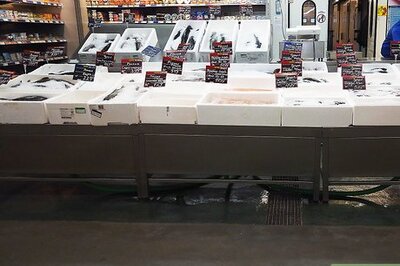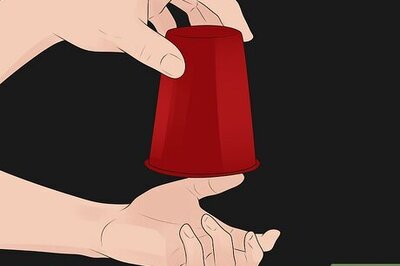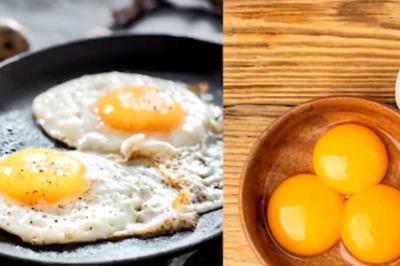
views
Is it safe to use aluminum foil in an air fryer?
Yes, you can use aluminum foil in an air fryer as long as it doesn't touch the heat source. Your air fryer functions as a portable, countertop convection oven, evenly circulating the heat in order to cook foods at speedy rates. However, since the cooking area in an air fryer is more limited than that of an oven, here are some guidelines that can help you optimize your air frying experience, depending on the kind of air fryer you have. In a basket-style air fryer, which focuses on “frying” versus baking, you can use aluminum to line the basket where the food is being cooked. In an oven-style air fryer, which focuses on “baking,” you can use aluminum foil to line the basket, the bottom of the air fryer to collect drippings, or both. Microwave technology is what causes aluminum-based products to spark in the microwave, but don’t worry— air fryers do not use microwave technology. It’s important to note that the foil can disrupt the flow of heat distribution to the food, potentially leading to unevenly cooked or undercooked food. You may have to adjust cooking times when using foil to achieve best results.
How to Use Aluminum Foil in an Air Fryer
Make sure the foil is weighed down by the food. You don't want your French fries whizzing around in your air fryer like feathers in the wind, so make sure you've secured the foil by adding enough food in a single layer to the basket. If you have a basket-style air fryer, you may also fully remove the basket from the air fryer, wrap the foil around the basket, and reinsert it. Foil secured!
Use foil to cook different foods at the same time. One of the main perks of using foil is being able to divide the contents inside the basket, allowing you to cook all sorts of foods at once. You can make sections out of the foil, which is perfect if you don’t want different ingredients to touch!
Use foil to reheat leftovers. If you have leftovers that are already parceled in foil, unfolding them and placing them in the air fryer can restore them to their former crispy and yummy glory. This works on anything from meat to burritos to cookie dough.
Use foil to cook food in batches. Since all you have to do is remove the foil holding one batch of food in exchange for another, cooking in batches is easy peasy when using foil in an air fryer. If you want to crisp up a large batch of broccoli, doing it in turns can help streamline the process.
Use foil to cook saucy foods. Foods like chicken wings and cauliflower curry work well with aluminum, as the foil does away with the need to scrub burnt patches of sauce from the basket. The foil acts as a barrier between your appliance and problematic foods that may damage it– while also optimizing the flavor and cook of your food!
Use foil to cook foods that may roll around. Aluminum foil can safely secure foods that tend to get restless and move around in the air fryer, like fingerling potatoes or whole eggs. You can mold the foil into "slings," nests, or other shapes in order to hold the food, depending on what it is. You can even create ridges in the foil to mimic the surface of a grill, for increased crispiness.
Use foil to cook delicate and/or difficult foods. Certain foods may benefit from the added security of being cooked in a little foil parcel, like eggs in purgatory, facilitating transfer and clean-up. You can use a basket-shaped section of foil to safely take the dish out of the air fryer, with minimal risk of cracking the yolk preemptively.
When Not to Use Aluminum Foil
Don’t use aluminum foil if it’s not totally necessary. Your trusty air fryer works by circulating heat in an enclosed space, which is why almost all air fryers are equipped with holed baskets. The aluminum foil may hinder the intended level of heat circulation, so opt out of using foil if it’s not absolutely necessary, as it could lead to faster, more evenly cooked food. Additionally, although consuming aluminum in trace amounts is not considered harmful, here are some things to think about before prepping for an air fryer feast. Sticky foods cooked at temperatures of 400 degrees Fahrenheit or over may cause more absorption of the metal into the food, and therefore, in your body. Small quantities of aluminum can be expected to quickly leave your body via urine or your digestive tract. Aluminum is naturally found all around us, including in water, soil, cosmetic products, and deodorants. These negligible amounts don’t appear to pose any real health threats.
Don’t use aluminum foil to cook acidic foods. Citrus fruits like oranges and tomatoes, along foods marinated in vinegar, for example, don’t work well with aluminum foil. The high concentration of acid in these foods causes the foil to break down and consequently leach onto the food, resulting in more significant amounts of metal consumption, which should be avoided. A 2012 study monitored the effects of cooking high acid foods in aluminum and determined that leaching was further increased when adding salt and spices. The results concluded that cooking acidic foods on aluminum foil contributed significantly to the absorption of the metal and are therefore not recommended due to health concerns.
Can you use parchment paper in an air fryer?
Yes, as long as it’s weighed down and not touching the heat source. Parchment paper is even lighter than aluminum, so make sure that it is properly weighed down by adding a significant amount of food in a single layer. It’s also important that it does not come into contact with the heating element, as this can damage the appliance, the parchment paper, and worst of all, the food. You can cut parchment paper to best fit the shape of your air fryer basket or even invest in pre-trimmed parchment paper with holes in it to catalyze even cookery. Parchment paper is not the best option for wet foods as it is less stable than aluminum. Do not used wax paper as it is not heat proof enough and may catch on fire.
















Comments
0 comment